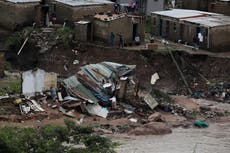Berkeley bores 400ft hole on campus in bid to cut emissions with geothermal
The California university is investigating a geothermal heating and cooling system
One of California’s most prestigious schools is boring a giant hole on campus to experiment with a renewable geothermal heating and cooling system.
The University of California, Berkeley has drilled 400-feet underground as part of its research into geothermal heat exchange — a system that stores heat in the ground to regulate indoor temperatures.
According to a recent video from the university, the project is part of a plan to reduce the school’s overall carbon footprint.
“You have a target of having zero carbon energy for our buildings by the year 2035 or sooner,” Kira Stoll, UC Berkeley’s Chief Sustainability and Carbon Solutions officer, said in the video.
Geothermal heat pumps use the ground as a “thermal battery,” say James Tinjum, an engineer at the University of Wisconsin who’s worked on geothermal heat exchange for over ten years.
How it generally works is that in summer, water carries excess heat through long underground pipes. There, heat shifts into the surrounding earth and the liquid comes back up colder — where it’s used to cool the air that circulates through the building, he says.
In winter, the liquid does the opposite: pulling heat from the ground and helping to warm the building’s air.
In the most efficient systems, the heat deposited underground during summer can be stored into winter since heat sticks around much longer in solid ground than in the air, Dr Tinjum says. Additionally, the ground stays at a much more stable temperature than the air throughout the year.
In the United States’ Upper Midwest, for example, the ground stays around 12 degrees Celsius (54F), according to Dr Tinjum. Air temperatures in the region can reach over 27 degrees C (81F) in the summer and minus -14C (7F) in the winter.
“That relatively constant temperature does not take that much energy to heat to 70 degrees when we’re doing heating,” Dr Tinjum says. In summer, it’s more efficient to use that cooler temperature already underground than try to chill hot air above ground, he adds.
“It’s just so much more efficient to use that constant temperature that’s below our feet.”
Geothermal heat exchange is different from geothermal electricity production - where pipes travel thousands of feet underground to fuel a power plant. Shallower, geothermal exchange systems can still reduce reliance on fossil fuels, like gas or oil, since buildings pull up heat already stored underground instead of producing new heat through combustion or electricity.
In doing so, geothermal heat pumps also have the potential to significantly reduce heating and cooling costs. Some of the larger, more efficient setups, can reduce the primary energy needed for heating and cooling by about 60 per cent, Dr. Tinjum says.
How well these systems work largely depends on the local geology, and that’s part of what the Berkeley team is studying. In addition to storing the heat produced by air conditioning, they’re also looking into the possibility of capturing heat produced by computers and refrigeration.
Berkeley isn’t the only college to experiment with geothermal exchange heating and cooling, either. In recent years, schools such as Princeton University, Ball State University and the University of Notre Dame have been investigating or installing similar systems.
The technology has been around since the 1940s, according to the Department of Energy. But at least in the US, widespread adoption of the renewable system has been limited by the dominance of inexpensive oil and gas, says Dr Tinjum.
Even though annual heating and cooling costs can go down with geothermal, there is a high initial cost of installation, and savings can take a few years to break even, Dr. Tinjum says. But as the cost of traditional fossil fuels rises, the time required to recoup the initial investment drops, he adds.
Join our commenting forum
Join thought-provoking conversations, follow other Independent readers and see their replies
Comments


Bookmark popover
Removed from bookmarks